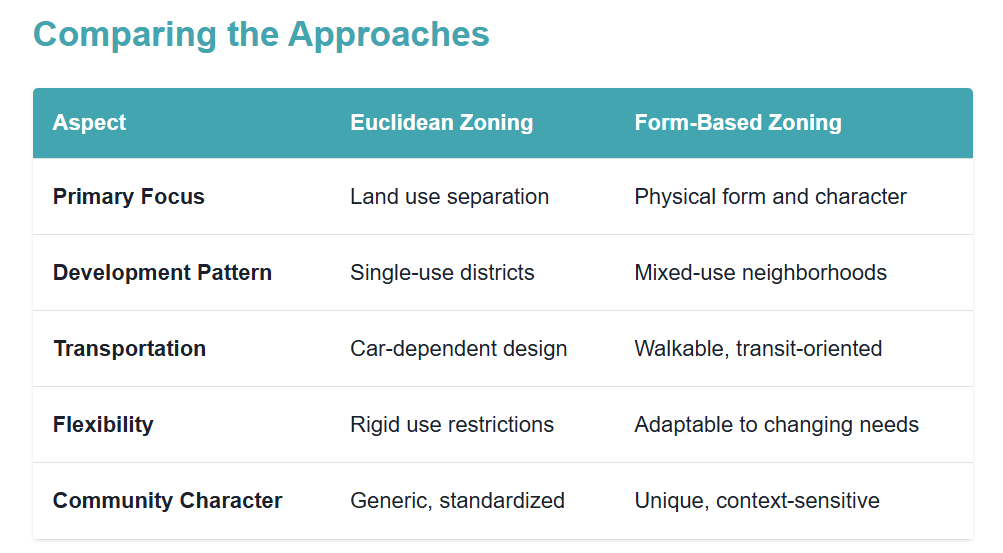Back to Blogs
Euclidean vs. Form-Based Zoning: Understanding the Impact on Community Design
Al Dhakal
September 4, 2025
3 min read


Ever wondered why some neighborhoods feel lively and walkable, while others seem spread out and car-dependent? The answer often lies in zoning — the invisible hand that shapes how our communities look, feel, and function.
The Zoning Evolution
For decades, cities have relied on traditional Euclidean zoning — named after the landmark 1926 Supreme Court case Village of Euclid v. Ambler Realty Co. — which separates land uses into distinct districts. While this approach solved many problems of the industrial era, it has created new challenges for modern communities.
Today, many cities are exploring form-based zoning as an alternative that prioritizes the physical form and character of buildings over their specific use. This shift represents a fundamental change in how we think about urban development.
Traditional Euclidean Zoning
Euclidean zoning focuses on use-based regulations. It creates separate districts for residential, commercial, and industrial uses, with strict rules about what can be built where. This approach emerged in the early 20th century to protect residential areas from industrial pollution and noise.
Characteristics of Euclidean Zoning
• Use-based separation: Residential, commercial, and industrial areas are strictly separated
• Density controls: Limits on units per acre, floor area ratios, and building heights
• Setback requirements: Mandatory distances between buildings and property lines
• Parking minimums: Required parking spaces based on building size or use
• Single-use districts: Areas designated for only one type of land use
Form-Based Zoning
Form-based zoning prioritizes the physical form and character of buildings and streets over their specific use. It focuses on creating walkable, mixed-use environments that support vibrant communities.
Characteristics of Form-Based Zoning
• Form-based regulations: Focus on building height, massing, and street frontage
• Mixed-use districts: Areas that allow multiple compatible uses
• Walkable design: Emphasis on pedestrian-friendly streets and public spaces
• Context-sensitive: Regulations that respond to existing neighborhood character
• Performance-based: Standards based on outcomes rather than prescriptive rules

Real-World Impact
The choice between Euclidean and form-based zoning has profound implications for how communities develop and function. Euclidean zoning often results in:
• Sprawling development patterns that require cars for most trips
• Monofunctional districts that lack vitality outside business hours
• Long commutes between separated uses
• Generic streetscapes that lack character and walkability
Form-based zoning, by contrast, typically creates:
• Walkable neighborhoods where daily needs are within easy reach
• Vibrant mixed-use areas that are active throughout the day
• Shorter trips and reduced car dependency
• Distinctive character that reflects local context and history
The Role of Technology
Understanding and implementing effective zoning strategies requires access to comprehensive data about existing conditions, development patterns, and community needs. This is where Conflation Labs’ conversational mapping AI becomes invaluable.
Our platform helps city staff and planners quickly access information about zoning districts, development patterns, and infrastructure requirements. Whether you’re working with traditional Euclidean zoning or implementing form-based approaches, having instant access to relevant data enables better decision-making and more effective community engagement.
Looking Forward
As cities grapple with challenges like climate change, housing affordability, and social equity, the choice of zoning approach becomes increasingly important. Form-based zoning offers a path toward more sustainable, livable communities, while modern technology makes it easier than ever to implement and manage these approaches effectively.
Read more articles
← Back to all blog posts
Originally published on Medium
